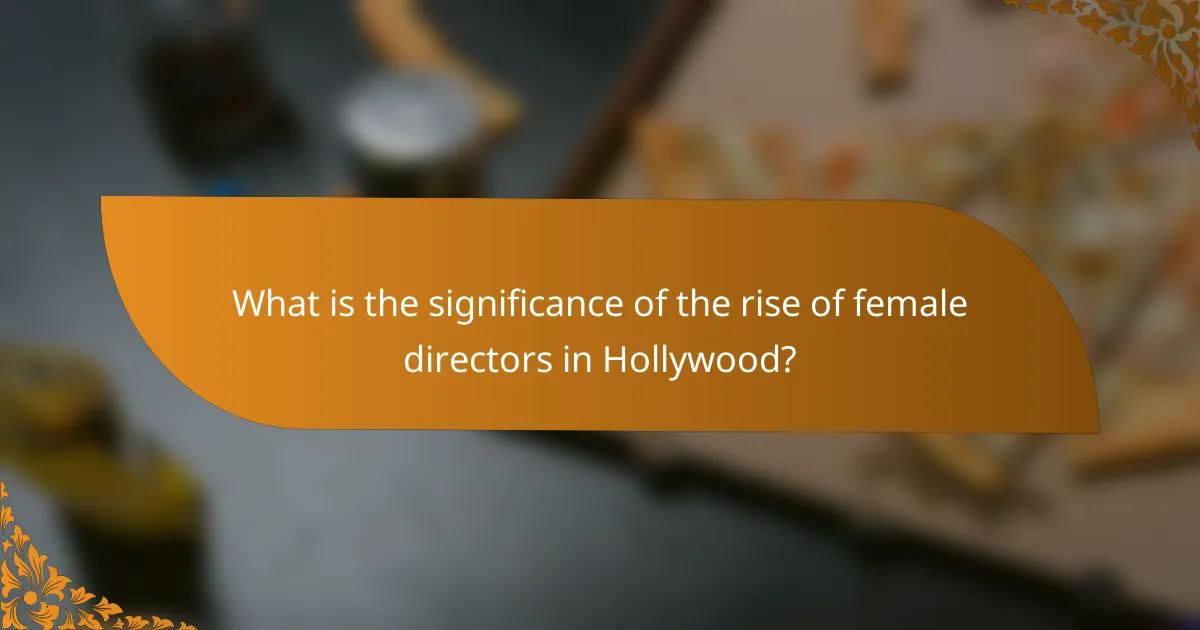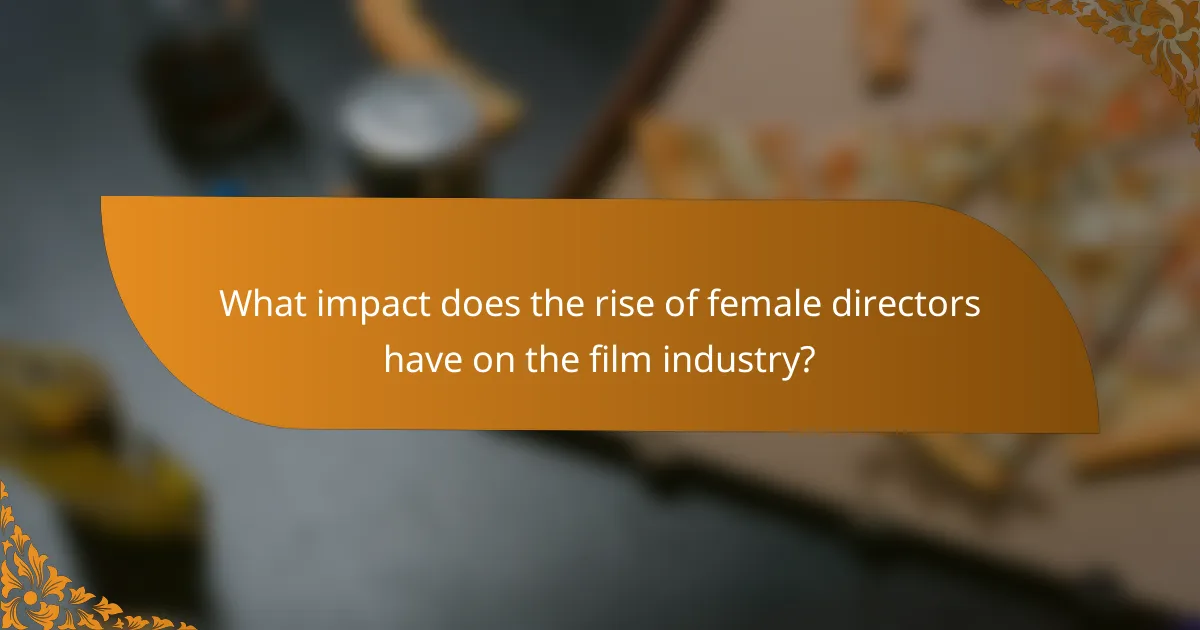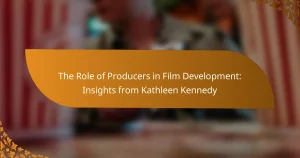
What is the significance of the rise of female directors in Hollywood?
The significance of the rise of female directors in Hollywood is profound. It marks a pivotal shift towards gender equality in a historically male-dominated industry. Female directors bring unique perspectives and storytelling techniques. This diversity enriches the cinematic landscape and broadens audience representation. According to a 2021 study by the Annenberg Inclusion Initiative, only 16% of directors in the top 100 grossing films were women. However, this figure has seen a gradual increase, reflecting changing industry dynamics. The success of films directed by women, such as “Lady Bird” by Greta Gerwig, demonstrates their ability to resonate with audiences and achieve critical acclaim. Furthermore, the rise of female directors inspires future generations of women in film. It encourages a more inclusive environment that values diverse voices and experiences.
How has the representation of female directors evolved over the years?
The representation of female directors has significantly improved over the years. In the early 2000s, female directors were underrepresented in Hollywood. Studies indicated that only about 5% of directors were women during this time. However, by 2020, this figure rose to approximately 16%. The success of films directed by women has contributed to this change. Notable examples include Greta Gerwig’s “Lady Bird” and “Little Women,” which received critical acclaim and commercial success. Initiatives advocating for gender equality in film have also played a role. Organizations like Women in Film and the 50/50 by 2020 campaign have raised awareness and pushed for more female representation. Overall, the evolution reflects a growing recognition of women’s contributions to the film industry.
What historical barriers have female directors faced in Hollywood?
Female directors in Hollywood have historically faced significant barriers. These include gender bias, lack of access to funding, and limited opportunities for key roles. For decades, industry norms favored male directors, often sidelining women. According to a 2019 report from the Center for the Study of Women in Television and Film, only 10% of directors of the top 100 grossing films were women. This disparity reflects systemic issues in hiring practices and networking opportunities. Additionally, women often encounter challenges in gaining recognition for their work. High-profile awards, like the Oscars, have historically favored male directors, further marginalizing female voices. These barriers have contributed to the underrepresentation of women in directing roles throughout Hollywood’s history.
How have recent movements influenced female representation in directing?
Recent movements have significantly influenced female representation in directing. The #MeToo and Time’s Up movements have raised awareness about gender inequality in the film industry. These movements have led to increased advocacy for women’s rights and representation behind the camera. Statistics show that female directors have gained more opportunities in recent years. For instance, the percentage of female directors in the top 100 grossing films rose from 4% in 2016 to 16% in 2021. This shift reflects a growing recognition of the need for diverse voices in filmmaking. Additionally, organizations and initiatives now support female filmmakers through funding and mentorship programs. Such changes indicate a positive trend towards greater female representation in directing.
Why is Greta Gerwig a pivotal figure in this rise?
Greta Gerwig is a pivotal figure in the rise of female directors in Hollywood due to her successful transition from actress to director. She gained recognition with her directorial debut, “Lady Bird,” which earned five Academy Award nominations. This film showcased her unique storytelling style and ability to connect with audiences. Gerwig’s follow-up, “Little Women,” further solidified her impact, receiving six Oscar nominations and praise for its modern adaptation. Her films often highlight female experiences, contributing to the broader movement for gender equality in the industry. Gerwig’s success has inspired a new generation of female filmmakers, demonstrating that women can lead major studio projects. She represents a shift in Hollywood, where female directors are increasingly recognized and celebrated.
What are the key works of Greta Gerwig that highlight her impact?
Greta Gerwig’s key works that highlight her impact include “Lady Bird” and “Little Women.” “Lady Bird,” released in 2017, received five Academy Award nominations. It was praised for its authentic portrayal of adolescence and mother-daughter relationships. Gerwig’s direction was noted for its emotional depth and humor. “Little Women,” released in 2019, received six Academy Award nominations. This adaptation was celebrated for its innovative narrative structure and strong female characters. Both films showcase Gerwig’s ability to tell compelling stories from a female perspective. Her works have significantly influenced the representation of women in cinema.
How has Gerwig’s style contributed to her success as a director?
Greta Gerwig’s style has significantly contributed to her success as a director through its distinct blend of authenticity and emotional depth. Her storytelling often features strong, relatable female characters. This focus resonates with audiences, particularly women, who see their experiences reflected on screen. Gerwig’s use of humor and vulnerability creates a unique narrative voice. This approach allows her films to balance lighthearted moments with serious themes. Her directorial debut, “Lady Bird,” received critical acclaim and multiple award nominations. The film grossed over $78 million worldwide, showcasing its commercial success. Gerwig’s follow-up, “Little Women,” further solidified her reputation. It earned six Academy Award nominations, including Best Picture. Her ability to adapt classic literature with a modern perspective has garnered both audience and critical praise.

What challenges do female directors, including Greta Gerwig, still face?
Female directors, including Greta Gerwig, still face significant challenges in the film industry. Gender bias remains a pervasive issue, affecting funding opportunities and project approvals. Studies show that female directors receive only a fraction of available financing compared to their male counterparts. Additionally, female directors often encounter stereotypes that question their capabilities. This can lead to fewer opportunities for high-budget projects. The representation of women in key creative roles remains disproportionately low. According to the 2021 report by the Center for the Study of Women in Television and Film, only 16% of directors of the top 100 grossing films were women. These systemic barriers continue to hinder the progress of female filmmakers in Hollywood.
What systemic issues persist in the film industry for female directors?
Systemic issues that persist in the film industry for female directors include gender bias and lack of funding. Female directors often face challenges in securing financing for their projects. According to a 2021 study by the Annenberg Inclusion Initiative, only 12% of directors for the top 100 grossing films were women. This disparity limits opportunities for women to showcase their work. Additionally, many female directors encounter stereotypes that question their capabilities. These biases can lead to fewer networking opportunities and mentorship. The industry still reflects a predominantly male perspective in decision-making roles. This systemic imbalance continues to hinder the progress of female directors in Hollywood.
How do funding and studio support differ for female-led projects?
Funding and studio support for female-led projects often differ significantly from their male counterparts. Female directors frequently face challenges in securing funding due to biases in the industry. Studies show that only 11% of directors in Hollywood are women, which reflects a systemic issue in support and resources. Additionally, female-led projects may receive smaller budgets compared to male-led projects. A report from the Center for the Study of Women in Television and Film found that films directed by women earned less funding on average. Furthermore, studios may prioritize male-led projects, impacting the distribution of resources. This disparity in funding and support can hinder the success and visibility of female-led films.
What role do industry biases play in the opportunities for female directors?
Industry biases significantly limit opportunities for female directors. These biases manifest in various ways, such as hiring practices and funding decisions. Historically, male directors have received more funding and support compared to their female counterparts. A 2020 report from the Center for the Study of Women in Television and Film found that only 16% of directors for the top 100 grossing films were women. This disparity indicates a systemic bias within the industry. Additionally, female directors often face stereotypes that question their capability to lead projects. These biases create barriers that hinder the progress of women in directing roles. Consequently, the representation of female directors in Hollywood remains disproportionately low.
How can the industry further support female directors?
The industry can further support female directors by increasing funding for projects led by women. Research shows that films directed by women often receive less financial backing. Providing mentorship programs can also help female directors gain valuable industry insights. Additionally, creating more networking opportunities can connect female directors with influential industry professionals. Implementing diversity quotas in hiring practices can ensure that women are represented in key decision-making roles. Lastly, promoting the work of female directors through awards and festivals can elevate their visibility in the industry. These measures can contribute to a more equitable environment for female filmmakers.
What initiatives are being implemented to promote female directors?
Various initiatives are being implemented to promote female directors. Organizations like Women in Film provide mentorship programs and funding opportunities. The Sundance Institute has a dedicated program for female filmmakers to enhance their skills. Additionally, the 50/50 by 2020 campaign aims for gender parity in film festivals and industry roles. Studios are increasingly investing in projects led by women, recognizing their success at the box office. Research shows that films directed by women often perform well, which encourages more studios to hire female directors. These efforts contribute to a growing representation of women in directing roles.
How can audiences contribute to the success of female-directed films?
Audiences can contribute to the success of female-directed films by actively supporting them through ticket purchases and word-of-mouth promotion. When audiences choose to watch these films, they help boost box office numbers. Increased box office success can lead to more funding and opportunities for female directors. Social media engagement can amplify visibility for these films. Audiences sharing their positive experiences can influence others to watch. Research shows that films with strong audience support often receive better critical reviews. This creates a positive feedback loop, encouraging studios to invest in more female-directed projects. Ultimately, audience support is crucial for changing industry dynamics.

What impact does the rise of female directors have on the film industry?
The rise of female directors significantly impacts the film industry by promoting diverse storytelling. Female directors bring unique perspectives that challenge traditional narratives. Their presence leads to more inclusive representation on screen. Studies show that films directed by women often feature stronger female characters. This shift can attract wider audiences and increase box office revenues. For instance, films like “Little Women,” directed by Greta Gerwig, received critical acclaim and commercial success. Additionally, female directors often prioritize collaboration and mentorship, fostering new talent. This evolution in leadership can transform industry norms and practices.
How does female direction influence storytelling in Hollywood?
Female direction significantly influences storytelling in Hollywood by introducing diverse perspectives and narratives. Women directors often highlight themes of identity, relationships, and social issues. Their storytelling approaches frequently challenge traditional gender roles and stereotypes. Films directed by women tend to feature complex female characters and authentic experiences. For instance, Greta Gerwig’s “Lady Bird” showcases a nuanced coming-of-age story that resonates with many viewers. Research indicates that films directed by women receive higher ratings for emotional depth and character development. The inclusion of female directors fosters greater representation in the film industry. This shift contributes to a richer and more varied cinematic landscape.
What unique perspectives do female directors bring to their films?
Female directors bring diverse perspectives to their films that often reflect their unique experiences. They frequently highlight female narratives and explore themes of gender identity and empowerment. This approach can lead to more nuanced character development and storytelling. Research indicates that films directed by women often feature stronger female characters. According to a study by the Geena Davis Institute on Gender in Media, female-directed films are more likely to portray women in leadership roles. Additionally, female directors often prioritize collaboration and inclusivity in their filmmaking processes. This results in a more diverse range of voices and stories being represented on screen. Overall, their perspectives contribute significantly to the richness and variety of contemporary cinema.
How do female directors reshape audience expectations and experiences?
Female directors reshape audience expectations and experiences by introducing diverse narratives and perspectives. They often challenge traditional gender roles in storytelling. This results in richer character development and more authentic representations of women’s experiences. For instance, Greta Gerwig’s films, such as “Lady Bird” and “Little Women,” highlight complex female relationships. These narratives resonate with audiences seeking relatable content. Research indicates that films directed by women often perform better in terms of audience satisfaction. A study by the Geena Davis Institute found that female-led films attract larger, more diverse viewership. Female directors also bring unique visual styles and thematic elements, enhancing the cinematic experience. Their contributions encourage broader discussions about gender equality in the film industry.
What best practices can aspiring female directors learn from Greta Gerwig?
Aspiring female directors can learn several best practices from Greta Gerwig. First, they should embrace their unique voice and vision. Gerwig’s films often reflect her personal experiences and perspectives. This authenticity resonates with audiences and enhances storytelling.
Second, collaboration is crucial. Gerwig frequently collaborates with diverse teams, including writers, cinematographers, and actors. This fosters creativity and inclusivity in the filmmaking process.
Third, aspiring directors should focus on character development. Gerwig’s films feature well-rounded characters that engage viewers emotionally. This approach helps create relatable narratives.
Fourth, persistence is key. Gerwig faced challenges in her career but continued to pursue her passion. Her determination serves as an inspiration for others.
Lastly, understanding the industry is vital. Gerwig has navigated Hollywood’s complexities, showcasing the importance of knowledge and networking. By following these practices, aspiring female directors can carve their paths in the film industry.
What strategies did Gerwig use to overcome obstacles in her career?
Greta Gerwig used several strategies to overcome obstacles in her career. She embraced her unique voice and perspective, allowing her to stand out in a male-dominated industry. Gerwig focused on writing and directing projects that resonated with her personal experiences. This authenticity helped her connect with audiences and critics alike. She also built strong collaborations with other female filmmakers, creating a supportive network. Gerwig’s persistence in pursuing her vision led to successful films like “Lady Bird” and “Little Women.” These films received critical acclaim and numerous awards, validating her approach. Additionally, she leveraged social media to engage with fans and promote her work effectively. Overall, Gerwig’s determination and innovative storytelling have played crucial roles in her success.
How can emerging female directors build their networks and support systems?
Emerging female directors can build their networks and support systems by actively participating in industry events. Attending film festivals and workshops provides opportunities for connection. Joining organizations focused on women in film can enhance visibility and access to resources. Networking on social media platforms like LinkedIn and Twitter fosters professional relationships. Collaborating with other filmmakers creates shared experiences and mutual support. Mentorship programs can offer guidance and industry insights. Engaging in community projects can expand local connections and resources. These strategies are essential for navigating the competitive landscape of the film industry.
The main entity of this article is the rise of female directors in Hollywood, with a specific focus on Greta Gerwig. The article highlights the significance of increased female representation in directing roles, the historical barriers faced by women in the industry, and the impact of recent movements advocating for gender equality. It examines how female directors, particularly Gerwig, influence storytelling and audience expectations, while also addressing the systemic challenges they continue to face. Key examples of Gerwig’s successful films, such as “Lady Bird” and “Little Women,” are discussed to illustrate the positive shift in the industry and the ongoing need for support and funding for female-led projects.


